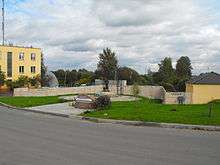Vitebsk Ghetto

Vitebsk Ghetto or Witebsk Ghetto was a short-lived ghetto in the town of Vitebsk in modern-day Belarus. It was created soon after the German invasion of the Soviet Union; immediately after the Nazs took control of the town on 11 July 1941.
Approximately 16,000 Jews lived in the ghetto.[1] In October, the Nazi administrators declared that the poor conditions in the ghetto created a health hazard for local inhabitants and that an epidemic had started in the ghetto; in fact, this declaration was a pretext to move and massacre the Jews. Less than three months later, on 8 October 1941, the Nazis started a massacre of the Vitebsk Jews, which ended on 11 October with the deaths of most of the ghetto's inhabitants (sources vary as to the exact number).[2] Many bodies were disposed in the nearby Vitba river.
See also
References
- ↑ Alexander Kott, Elisheva Kott A Wedding in Darkness: One Life in the Twilight of Russian Jewish History 2003 p.122 "Grune and her two remaining children were interned in the Vitebsk ghetto together with 16,000 other Jews. The ghetto was established in the area of the Vitebsk railway station and surrounded by wire fences. "
- ↑ Peter Longerich Holocaust: The Nazi Persecution and Murder of the Jews 2010 p.223 "Thus, to name only the most significant places, the Vitebsk ghetto was cleared between 8 and 10 October and 4090 Jews were shot (according to reports by Einsatzkommando 9)" - but another source puts this 4,090 at December 1941
External links
| Wikimedia Commons has media related to Ghetto Vitsebsk. |
- October 8: Vitebsk Ghetto liquidated; more than 16,000 Jews killed, via Yad Vashem
- VITEBSK AND THE HOLOCAUST
Coordinates: 55°06′50″N 30°06′54″E / 55.1140°N 30.1150°E